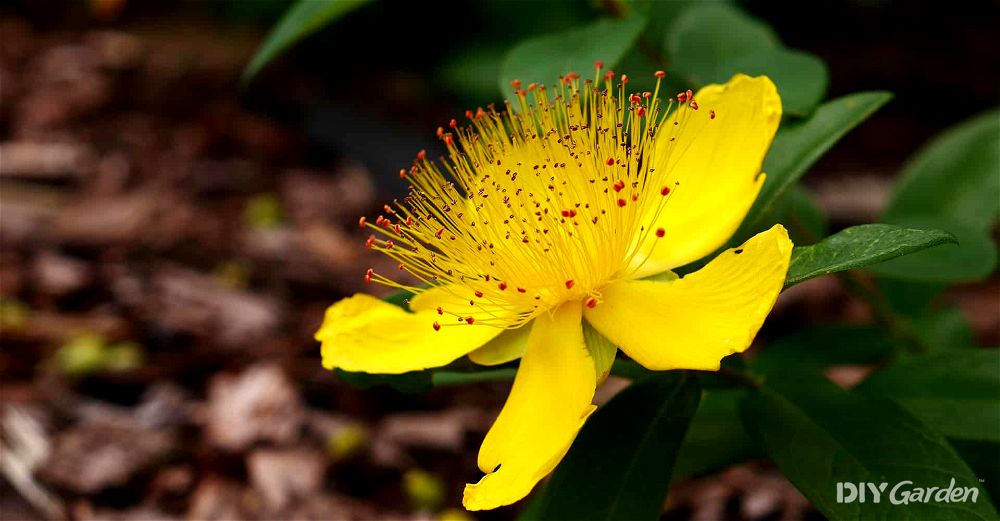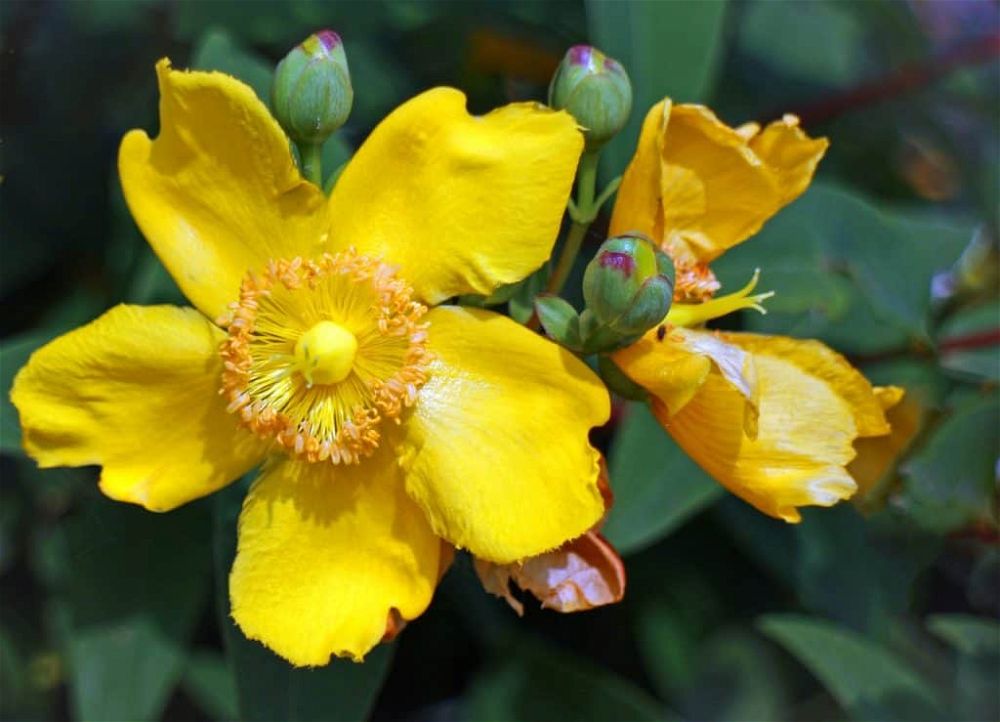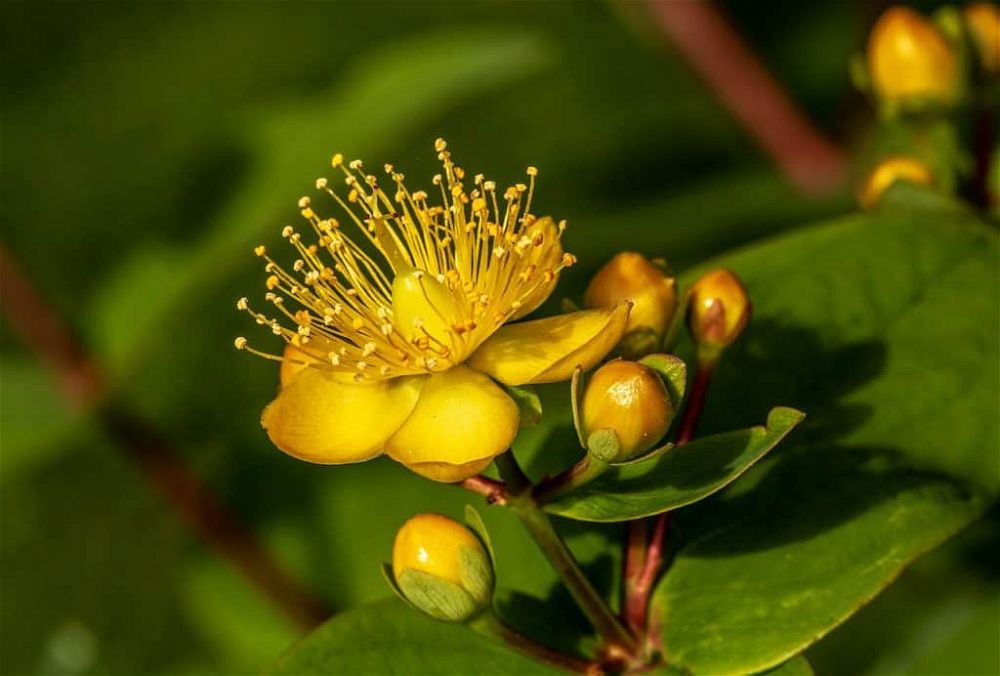
Jump to a Section
Plant Overview
| Common Name | St John’s Wort, Rose of Sharon, Goldflower |
|---|---|
| Scientific Name | Hypericum |
| Plant Family | Hypericaceae |
| Origin | The origins of Hypericum are difficult to determine as it is now so widespread |
| Height | Upright varieties grow to a maximum height of 1.5m / 5ft. Spreading varieties generally reach only 60 cm in height but can spread to 1.5 metres across |
| Light | Flowers best if it gets at least half of each day in sun |
| Temperature | May lose some leaves at temperatures below -3 but will not suffer any long-term damage and will be perfectly fine up to at least -14 |
| Hardiness | Fully hardy |
| Soil | Hypericum grows in most soil types but has a preference for soil with a pH of between 5.5 and 7. It does not like waterlogged soil |
| Fertiliser | Apply a yearly slow release fertilizer and use a liquid feed monthly during the flowering season |
| Propagation | You can propagate these plants by seed, cuttings or root divisions |
| Pests | Scale insects, Root-knot nematodes |
| Difficulty | Easy |
Hypericum, also known as Rose of Sharon or St John’s Wort, is grown for its profusion of golden- yellow flowers from July to October. Many types are evergreen or semi-evergreen. This is a tough, hardy and easy to grow shrub that will add structure and a splash of summer colour to the garden.
Read on to find out about how to care for your plant. We’ve written about different varieties, maintenance and propagation, and what to do if any problems arise.
Hypericum Care
Hypericum is easy to look after and does not usually cause many problems to the gardener. Once they are planted in a suitable position, they will usually grow and flower freely with little interference. This is why they are used so much in council landscaping schemes. However, a little attention can improve the flowering of your shrub.
Light Requirements
Hypericum can manage with part shade, however, they do flower best when they get plenty of sun. The variety “H. Calycinum” can cope with more shade than other varieties (as little as two hours a day).
Most other varieties require a good portion of the day in the sun to flower well.
Water Requirements
Like most plants, hypericum does not like to sit in wet soil. Overwatering can cause the roots to rot. Allow the soil to almost dry out between watering.
Soil Requirements
Hypericum will cope well with most soils including sandy or clay soils. In fact, they are fine in all but waterlogged soil. Their preference, however, is for a soil with a pH of between 5.5 and 7.
Fertiliser Requirements
Good nutrition will increase the flowers produced by your shrub. You should apply a slow release fertiliser in spring, working it into the ground a little.
Thereafter, use a well-balanced liquid fertiliser monthly, throughout the growing season. Alternatively, you can apply well-rotted manure.
Planting
Planting hypericum is best done in spring.
If your soil is poor, add in some well-rotted manure before planting. If the soil has a tendency to hold water, then a good amount of grit should be added to improve drainage.
Dig a hole twice the width of the rootball and position the plant so it is at the same level as in the pot. Backfill and water in well.
Many of these shrubs grow quite large, so you should allow plenty of space for them to grow. Dwarf varieties can be planted closer together. If planting as a hedge they can be positioned about 45 cm (18 inches) apart.
You should continue to water your plant regularly until it is well established.
Maintenance
Hypericum generally requires little maintenance. A tidy up in early spring is enough to keep it in good shape. You will also need to water your plant during spells of dry weather.
Repotting
Hypericum can be grown in a pot but this is not their ideal situation. If you do grow them in a container choose one that is larger than the rootball.
You should repot once the roots fill the pot and begin to protrude through the drainage holes. Use a good quality loam-based compost. In years when the plant does not need repotting, scrape away the top few centimetres of compost and replace it with fresh.
Looks Good With
Hypericum is a useful shrub in the garden providing good colour and structure. It is a great addition to the mixed border and the smaller varieties are good in the rockery or at the front of the border. Their long flowering period means they offer colour and interest throughout the summer months.
Their bright yellow flowers do not look out of place in a tropical style garden but are subtle enough to blend in well with a more cottagey style, too. They look wonderful combined with rudbeckia and ornamental grasses.
This plant is hardy and salt tolerant enough to grow in a coastal location.
Pruning Advice
Most types require little pruning. You may want to give them a tidy up in spring to remove dead wood. Do this just before they begin to leaf out.
You can also prune them to keep them to a certain size at this time. They will be perfectly happy having between 50% and 75% of their top growth removed. Some spreading varieties, such as Calycinum are more vigorous and can be cut down to ground level in March.
It is not advisable to undertake any pruning after late summer.
Hypericum Propagation
Hypericum can be propagated by seed, cuttings or root divisions.
You may also find that your hypericum self-seeds and you can take these seedlings and pot them up to get them off to a good start. Some ground cover varieties also spread themselves around the garden. These new plants can be moved to a more suitable position if they are too close to the parent plant.
Propagating Hypericum by Seed
You can start your seeds in small pots indoors around 10 weeks before you expect spring to begin. Place them on a windowsill that is warm but does not get too hot.
Once your plants have grown reasonably substantial they can be hardened off. Wait until the weather is warmer and all chance of frost has passed before putting them outside.
Propagation by Cuttings
You can take cuttings in late spring or early summer.
If the weather has been dry, water your shrub well the day before taking cuttings so that the stems are full of water. It is also best to take cuttings early in the day. Choose healthy, new, non-flowering shoots as these will root most easily.
Take cuttings of 10 cm (4 inches) in length, cutting just above a leaf bud as this is where the new roots will form. Pinch out the soft tip and remove the leaves from the lower third of the stem.
Dip the base of the stem in rooting hormone powder. Insert the cutting into holes made with a dibber or pencil in 4-inch pots of potting compost. The compost should be a cutting mix or compost with added grit to help with drainage. Mist well and cover the pots with a roomy plastic bag held secure with an elastic band or tie.
The cuttings should be placed in a sheltered position in bright, but not direct sunlight. Remove the bag each week for at least ten minutes to give them an airing. At this time, you should also water them and remove any dead or dying matter. Once you see signs of new growth you can remove the bags.
Harden off your plants before planting them out into their final position in the ground.
Propagation by Root Division
To propagate by division, you should dig up the entire plant taking care not to damage the roots.
Separate the rootball into several pieces. It may come apart quite easily, but it might be necessary to use a sharp knife to cut the rootball into pieces. You can then replant the divisions, or, if they are small you may like to pot them up until you see signs of new growth before planting them out.
Common Hypericum Problems
Hypericum is usually pest and disease free. However, keep an eye out for the following problems as they can be treated most easily if caught early.
Pests
There are a couple of pests that have the potential to cause hypericum some problems.
Scale Insects
If you see brownish bumps on the stems, especially where twigs join or near buds, then you may have scale insect. These insects suck the sap of the plant and excrete honeydew which can lead to sooty mould growth. The insects cover themselves with a waxy shell which makes them hard to remove with insecticides, however, insecticides can be used against the young nymphs.
You can scrape off scale insects with a cotton swab soaked in alcohol. If the problem is extensive, remove and dispose of all infected branches. You may need to use an insecticide spray, however, avoid doing this when the shrub is in flower as it may harm pollinating insects.
If scale is a recurrent problem, spray the plants in late March or early April.
Root-Knot Nematodes
Nematodes are tiny, translucent, wormlike creatures that are difficult to see with the naked eye. If your hypericum is affected it may have wilted and yellowing foliage especially in hot weather. This is because the damage to the root system makes it difficult for the plant to get enough water and nutrients. As fungus can attack the nematodes, an application of rotted leaf litter can help. A diluted fish emulsion can also repel nematodes.
Diseases
There are a couple of diseases which may also affect your hypericum.
Powdery Mildew
If the leaves of your plant are coated with a white powdery substance, this indicates powdery mildew. This disease often occurs in humid conditions. For this reason, increasing air circulation around the plant often helps.
You should cut back any plant that are encroaching on your hypericum’s space as well as removing any weeds form the surrounding area. In addition, you may like to thin out the branches of your plant to allow the air to circulate more freely through it.
It is also advisable to water the plant at the roots rather than from the top. This helps avoid creating the humid conditions that this fungal disease loves. Watering your plant early in the day can make sure the leaves get a chance to dry out before cooler night time conditions.
Rust
Occasionally hypericum may be affected by rust. If this affects your plant you will see pale areas on the upper surfaces of the leaves and brownish, reddish or orangey spots on the undersides. You should remove the affected leaves as soon as possible. Destroy all fallen and infected leaves to prevent the spread of rust. Again, improving air circulation around the plant can help. You can also use a fungicide early in spring.
Hypericum Varieties
Here’s a run down of the different varieties, all have yellow flowers ranging from 4-7cm (1 ½-3 inches) and most have reddish brown fruit in late summer.:
H. Hidcote
The most widely grown variety is ‘Hidcote’ and this can be seen in many parks and gardens as well as around supermarkets and business parks. It is hardy and trouble free and has large saucer-shaped flowers. The shrub will reach an ultimate height of 1.2 metres (4 feet) and so is suitable for the back of the border. It can even be used as a colourful hedge.
H. Calycinum
This is a spreading type that reaches only 60 cm (23 inches) in height but will spread for up to 1.5 metres (5 feet). It is a lovely plant to use for ground cover. It can tolerate more shade than other varieties.
H. Moserianum
This is a dwarf deciduous shrub with a spreading habit. It has arching red stems and golden yellow flowers of up to 5cm across in summer. This variety is often known as goldflower.
H. Addingtonii
This variety reaches around 2 metres (7 feet) in height. It has arching branches and oval leaves. The flowers are bowl-shaped and can be up to 5 cm across. They appear singly or in clusters in summer.
H. Monogynum
This small variety reaches a maximum height of 90 cm (3 feet). It is evergreen and has small sprays of golden flowers from summer through to autumn. The flowers have many beautiful stamens making this variety quite distinctive.
H. Kouytchense
This is a small, semi-evergreen variety and has lovely large golden flowers with long stamens.
H. Olympicum
This deciduous variety is a dwarf type and will reach a diminutive 25 cm (10 inches) in height. Its small but perfectly formed leaves are greyish green. Despite the size of this shrub, it still produces clusters of flowers that are up to 5 cm across. It is perfect for the front of the border or for rock gardens.
H. Lancasteri
This shrub is deciduous and has a spreading habit. It bears sprays of large, slightly cup-shaped flowers in summer.
H. Subsessile
This deciduous shrub tops out at around 1.2 metres (4 feet) in height. It has upright arching stems and narrow oval leaves. The buds are flushed red and open to flowers with conspicuous stamens. It also produces dark red berry-like fruits in late summer.
H. Forrestii
This small evergreen shrub has leaves that turn orangey-red in winter. Its flowers are like large buttercups, smoothly rounded and a clear bright yellow.
FAQs
This has been an exceptionally harsh winter and hypericum often do lose some of their leaves when the temperatures fall very low.
Your plant is unlikely to have suffered any permanent damage.
Early spring is the ideal time to prune your hypericum, so you can cut back the damaged wood and you will soon see plenty of fresh new growth. Your plant will benefit from this regeneration and may well flower better than ever this year.
It sounds like your plant is producing foliage at the expense of flowers. Fertilising every two weeks is probably too much and is providing your plant with too much nitrogen. When growing plants for fruit or flowers, you should use a fertiliser that is lower in nitrogen and higher in phosphorous. I would stop fertilising your shrub for at the least the remainder of the year. You could also apply some bone meal to increase the phosphorous and get the plant back to balance.
If you choose the right variety, then you can have a hypericum in this position. Hypericum ‘calycinum’ (Rose of Sharon) does quite well in the shade whereas ‘Hidcote’ does best if it gets at least half a day’s sun.



Share